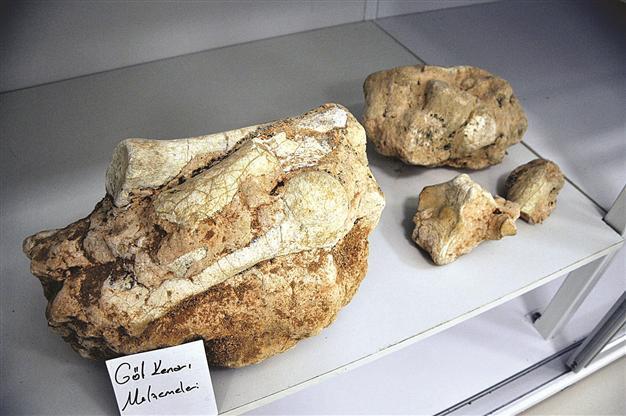Project to reveal central Anatolian history
KIRŞEHİR – Anadolu Agency

‘After the animal bones were found during surface survey, the region needs a wider study. Further research may bring further results,’ says Professor Ahmet Cem Erkman.
After rhino, giraffe and elephant bones were found during a surface survey in the Hirfanlı Dam Lake, excavations have been initiated in the area. It is expected that the natural history of Anatolia from 5 to 8 million years ago will be revealed.The project was formed after Ahi Evran University (AEÜ) Kırşehir Surface Survey Research Group President and Associate Professor Ahmet Cem Erkman and his team found the bones on the Savcılı coast of the Lake Hirfanlı. With the support of the Culture and Tourism Ministry, the AEÜ and the Turkish History Foundation retrieval excavations will start in September.
Erkman said the head of the excavations will be Kaman Kalehöyük Archaeology Museum Director İzzet Esen and he will be the head of scientific commission. Stating that academics from Van’s Yüzüncü Yıl University and Ankara University will also work with the project, Erkman said:
“After the animal bones were found during surface survey, the region needs a wider study. The scientific data are very striking since they show the biological richness of the Kurutlu/Kaman location. In the region, where backboned fossils from 5-8 million years ago have been discovered, we will try to reveal the nature history, life and environmental factors of Central Anatolia before human life. The people of Kırşehir are living on very precious natural history. This is just the beginning. Further research may bring further results.”
Drought to ease things
Erkman said the place where excavations will start is close to the coast of the lake and they are waiting for the water level to drop to begin excavations.
“It is bad for our farmers, but the drought will make things easier for us because it will decrease the water level of the Hirfanlı Dam Lake. It will be enough for us even if the water shrinks one meter.
Otherwise, we will work inside the water. We will call underwater experts if necessary. We had talks with the General Directorate of State Hydraulic Works (DSİ); they said September will be okay for water to evaporate some,” he said.
The idea for retrieval excavations came with the bones found during the surface survey, said Erkman, and continued: “We found two rhinoceros bones during the excavations in the region. Then we found elephant and giraffe bones. They were next to the water and we thought this place had great potential. The water carried them to the surface. The history of Anatolia cannot be found in any other country. Kırşehir also has great potential in terms of natural history.”
Erkman noted that the findings to be unearthed during the excavations would be displayed at a museum not yet established at the Ahi Evran University.
















